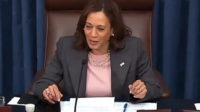Although U.S. greenhouse gas emissions have fallen since peaking in 2007, reductions are not on a trajectory to meet targets to avoid increasingly severe weather events, according to the Fifth National Climate Assessment released Nov. 14.
The Biden administration released the report in advance of COP28, the annual United Nations Climate Conference, which will be held Nov. 30 to Dec. 12 in Dubai, United Arab Emirates.
Along with the new climate analysis, the Biden administration on Nov. 14 announced more than $6 billion in investments to improve national resilience to climate change impacts—including funding for projects to reduce flood risk, update water infrastructure in the western U.S. and improve resilience of the electrical grid—all needed to combat increasing global temperatures “unequivocally” caused by human activity, the White House said.
While the U.S. has made progress in reducing climate emissions, “without deeper cuts in global net greenhouse gas emissions and accelerated adaptation efforts, severe climate risks to the United States will continue to grow,” said the assessment. Climate-change related extreme weather events cost the U.S. at least $150 billion each year, with a disproportionately high impact on underserved and under-resourced communities, it noted. The U.S. now experiences a billion-dollar disaster every three weeks on average, compared to once every four months during the 1980s, the report concluded.
“The Assessment is a stark reminder that, if we don’t act with urgency to tackle the climate crisis, Americans will experience increased suffering at the mercy of a changing environment,” said U.S. Secretary of Energy Jennifer M. Granholm in a statement.
Investing in the Future
Investments include $3.9 billion for the second round of funding in the DOE Energy’s Grid Resilience and Innovation Partnerships (GRIP) Program, which funds upgrades to aging electric grid infrastructure; and $300 million through the second round of the Federal Emergency Management Agency Swift Current initiative, which seeks to provide mitigation assistance to communities that are repeatedly affected by flooding disasters.
Last month, the GRIP program announced 58 projects receiving up to a combined $3.46 billion in the first round of funding authorized under the Infrastructure Investment and Jobs Act. Awards range from roughly $1.2 million for a grid-interactive efficient buildings network in Burlington, Vt., to $464 million for the Joint Targeted Interconnection Queue Portfolio, involving design, planning and construction of five transmission projects across Iowa, Kansas, North Dakota, Nebraska, Minnesota, Missouri and South Dakota.
The Interior Dept. also will soon announce $100 million for water infrastructure upgrades in western U.S. states experiencing drought, and $166 million authorized under the Inflation Reduction Act to support ecosystem resilience, restoration and environmental planning needs for the National Park Service.
More Reductions Needed
According to the National Climate Assessment, annual U.S. greenhouse gas emissions fell 12% between 2005 and 2019, peaking in 2007. The decline was driven largely by energy sector shifts from coal to more renewable power sources. In 2020, 80% of new generation capacity came from renewable sources. Despite these reductions, the U.S. population and gross domestic product have continued on upward trajectories.
Additionally, the costs of wind, solar and battery storage technologies have dropped, which has led to a 70% decline in energy costs from wind and a 90% drop for solar power over the past decade.
But these improvements are still insufficient for what’s needed, the report concluded. To halt the global temperature rise, global emissions need to decline to net-zero levels, it stated. Global average temperatures also are unlikely to fall for centuries unless carbon emissions become net-negative.
“We are woefully off-track,” said Louise Jeffery, who tracks climate change trends at the New Climate Institute, on a press call related to a separate report also released on Nov. 14. That analysis, State of Climate Action 2023, of which she also is a co-author, concluded that global efforts to reduce emissions are lagging far behind where they need to be. “We are seeing the impact of inaction unfold around the world—from extensive wildfires in Canada and heat-related deaths across the Mediterranean to record-high temperatures in South Asia,” Jeffery said.
The report was published by the Systems Change Lab, which is funded by a variety of climate-change related nonprofit organizations that include the Bezos Earth Fund, New Climate Initiative and World Resources Institute.
It warns that despite global progress in reducing emissions, efforts are not on track to limit global warming to an increase of no more than 1.5° C. As global leaders prepare to assess their progress in meeting target reductions, “It is our hope that this report informs decisionmakers on where and how to step up climate action,” Jeffery said.







Post a comment to this article
Report Abusive Comment